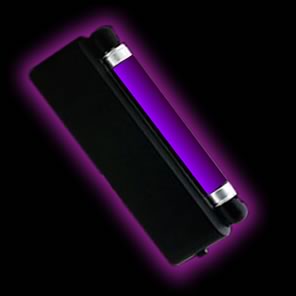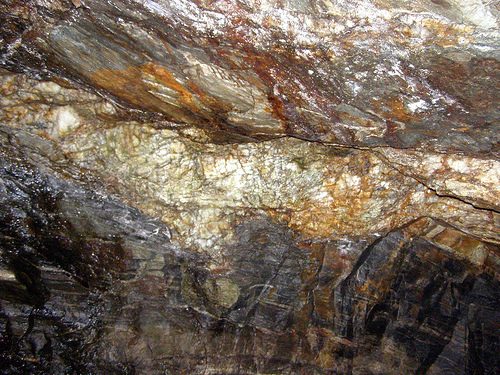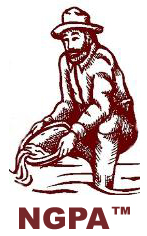Prospecting with a Blacklight

The knowledgeable prospector is very much aware that you can obtain a lot of information about ore bodies from fluorescent minerals, including those with no commercial value. Fluorescent non-commercial minerals can help (1) to determine the probable boundaries of an ore-bearing structure, such as a poorly defined vein; (2) allow you to judge whether adjoining rocks are favorable for the formation of ores; (3) to correlate formations with those of distant locations, revealing vein extensions; and (4) to uncover faults or slippages cutting off the vein.

By way of example, fluorescent calcite (which is often associated with deposits of silver ore) when found in close contact with the pay streaks in an ore body, can easily guide you in trenching or excavating. As long as your blacklight picks up the glow of fluorescent calcite in the gangue material, you have every reason to believe you are following the vein. Using this technique, you will be able to diagram a rough outline of the vein showing its trend and shape.
This same technique can be used where a tracer closely follows barren rock instead of ore. For instance, in a gold mine operated by a friend of the author’s, Howard Fisher, it was found that the ore-bearing quartz veins were accompanied by ankerite (non-fluorescent), while outside the ore body, barren quartz veins contained highly fluorescent calcite but no gold, thus giving Howard the probable limits of the productive zone.
Fairly common gangue minerals that can provide such fluorescent tracers include: dolomite, barite, gypsum, calcite, apatite and, in a few locations, rhodonite or rhodochrosite. Both experienced prospectors and professional geologists frequently use fluorescent “guides” to trace and find ore bodies.
A beam of ultra violet light is invisible to the naked eye; however, certain chemical impurities, or “activators,” in minerals cause an excitation of the atoms which produce a phenomenon known as fluorescence. A blacklight is no more than a mercury vapor lamp made of quartz glass which provides a rich source of ultra violet light; yet to keep out unwanted visible rays, a dark-colored filter is used.
Possibly one of the most useful prospecting “tools” that you can add to your arsenal of knowledge is knowing the association of minerals, based on the fact that certain minerals are formed under like conditions. Thus, ore bodies will be deposited only in environments where these favorable conditions exist. Find one of these, and you will find its associates.
Let’s say, for instance, that you are prospecting along the Colorado Plateau: experienced prospectors in this region have learned that torbernite and copper go together. It’s more than a coincidence as both copper and uranium are necessary ingredients of torbernite. Putting this association to work, the shrewd prospector who notices greenish copper streaks on an outcrop looks for tiny, square, green plates of torbernite; then, he searches for commercial deposits of copper ores, including chalcopyrite and chalcocite.
In another instance, a tin-bearing vein may contain any of a group of minerals deposited under high temperature conditions, including fluorescent minerals such as apatite, amblygonite, calcite, scheelite and fluorite as well as non-fluorescent minerals, such as: arsenopyrite, pyrite, molybdenite, kaolin, wolframite, bismuth, columbite, lepidolite, chlorite, pyroxene and quartz. Quite frankly, you wouldn’t suspect it was a tin vein until you found tin. However, had you recognized the half-dozen or more minerals of the “tin-vein” group, you might reason that a tin-bearing deposit was nearby and start searching for cassiterite. Keep in mind that while some metallic ores do not fluoresce (copper and silver minerals) they can sometimes be identified through their association with various fluorescent gangue minerals.

You’ll soon learn that it’s vital to understand in what kinds of rocks different metallic ores are found. Tin, tungsten and molybdenum almost always occur in or near coarsely crystalline igneous rocks, while platinum, chromium and nickel are usually found in or near close-grained igneous rocks. While no general rule can be made in regards to the association of rock types and ore minerals, the following chart may help you in your prospecting efforts.
The prospector should search for the listed rock types by looking for what’s known as “outcrops.” An outcrop is a surface exposure of an ore body. Keep in mind as you hike across the terrain that some outcrops appear as great masses of heavily mineralized siliceous rock while others are small but much richer. For instance, there are practically no outcrops at Cripple Creek, Colorado, a well-known, very rich mining district. Yet, other outcrops may contain huge masses of quartz but are worthless. Remember: it only takes a little copper to stain a lot of quartz and, as such, contains no ore shoots.
The question every prospector asks is: Where do I search? The most favorable regions are the volcanic areas. Almost in every instance, lode deposits of gold and silver are found on the surface in association with intrusive igneous rocks. As faults and fractures develop, conditions become ripe for ore deposition.
In the now classic reference, Handbook for Prospectors and Operators of Small Mines, the author (M. W. Von Bernewitz) states: “Low, rounded hills are often the result of complex faulting with at least two systems of intersecting faults. If such hills are of notably different outline from the general relief of a region, mineralized areas may be associated with such a feature.”
Bernewitz goes on to say: “Foothill country—that which leads to mountains, hilly country of medium altitude, and flat or rolling country—has been a prolific producer of metallic and non-metallic minerals.”
Let’s examine a few of the metallic and non-metallic ores from the standpoint of fluorescence and market values:
(1) Aluminum, whose chief ore is bauxite, is non-fluorescent. Gibbsite, another ore of aluminum, sometimes fluoresces bright green under long-wave UV. Diaspore, an ore of aluminum, occasionally fluoresces pale yellow under short-wave UV. Alunite can be an ore of aluminum or a source of alum or potash; more importantly, this mineral sometimes fluoresces white or orange under long-wave UV light.
(2) Beryllium, an important metal used in the defense and aircraft industries, is found in a number of minerals, which sometimes exhibit fluorescence, including: Beryl, emerald, chrysoberyl, alexandrite and herderite (FL deep blue under LW).
(3) Lead minerals and its tracers are well known for their brilliant fluorescence; however, the primary ore of lead, galena, does not fluoresce. Among the lead minerals that often fluoresce are: cerussite, which fluoresces bright to pale yellow; anglesite, which fluoresces bright yellow to yellowish white or cream; leadhillite, a rare mineral, but a worthwhile tracer, fluoresces orange or pale yellow; phosgenite, a rare secondary mineral of lead which is used by prospectors as a tracer, fluoresces yellow to orange; and, of course, that old favorite of collectors, mimetite, which sometimes fluoresces a medium orange-red under a short-wave blacklight.
(4) Molybdenum, used to harden high-quality steels, molybdenum is similar in this regard to tungsten. The primary ore of molybdenum is powellite, a calcium molybdate with a brilliant fluorescence, which is commonly found in scheelite, or tungsten ore deposits. Of all the molybdenum minerals, only powellite fluoresces a bright yellow under a short-wave blacklight. The best places to hunt for powellite are in silicified fractures or breccia zones. Rich ore bodies of powellite often take the form of “pipes”, which, though small in diameter, frequently travel for some distance. Quartz veins seldom run into commercial values. Current market price for molybdenum is very much on the rise as foreign sources are drying up.
(5) Tin is of great importance as reflected by its current market price, $4.07 per pound. Tin is frequently found and mined much like gold placers in stream gravels. In hardrock mines, tin is always found in either pegmatites or veins in contact with granite. The only commercial tin mineral, cassiterite, is a tin oxide. Although cassiterite is non-fluorescent, its associate minerals are fluorescent! In pegmatites, look for the following fluorescent minerals that are associated with cassiterite: amblygonite, apatite, spodumene, chrysoberyl, topaz and zircon. Stannite, another tin mineral, is uncommon and is non-fluorescent.
(6) Tungsten is the answer to the miner’s dream of electronic prospecting using an ultraviolet lamp. It’s main ore, scheelite, fluoresces an intense bright blue. Frequent associates of scheelite include: cassiterite, gold, bismuthinite, molybdenite, pyrite, apatite, calcite, garnet, epidote, fluorite, hornblende and topaz, among a few others. The current market price for tungsten is on the rise.
(7) Zinc minerals, often associated with lead deposits, are well known for their fluorescence. Zinc ores occur most often as cavity fillings or replacement bodies, which are found in limestones and dolomites, but can be found in many other rock types. Sphalerite is zinc’s main ore, which glows a bright orange color under short-wave UV light. Major mining corporations are always on the look out for large zinc deposits.
(8) Finally, of all the non-metallic ores, fluorite, which is known as fluorspar, is currently the most worthwhile mineral that amateur prospectors can prospect for using their ultraviolet lamps. Fluorspar is vitally important to the steel industry as it’s used as a flux. It’s a source of fluorine for hydrofluoric acid, a raw material for glass, ceramic and chemical industries. Old fluorspar mines are good candidates for the prospector with an ultraviolet lamp and a Geiger counter. Fluorite is most often found in veins, most commonly in limestones and dolomites, but you will find it as an accessory mineral in igneous rocks. Uranium is often disseminated in fluorspar; hence, the need for a Geiger counter when prospecting for fluorspar. Fluorite fluoresces a deep blue color and sometimes phosphoresces after you turn off the lamp. Good quality fluorspar is always in demand.
Portable blacklights, or ultraviolet lamps, are sold at rock shops and prospecting supply stores. One firm that manufactures blacklights is Ultra-Violet Products of San Gabriel, CA (1-800-452-6788). They make AC/DC powered blacklights with rechargeable batteries. Their lamps have both long and short-wave tubes built into one compact unit. However, the majority of ores and minerals respond only to short-wave radiation, so don’t worry if you can afford only a short-wave lamp!
UV Systems of Renton, Washington (1-800-228-9988), makes the most powerful and brightest portable blacklight in the business, the SuperBright 2000 SW. It’s a one of a kind design featuring instant start-up, a U-shaped quartz tube that nearly doubles the effective power, an adjustable pistol grip, a battery pack that can be recharged and a convenient car lighter cord. If you’re going to search mines and mine dumps for mineral specimens, or if your intent is to use a blacklight for prospecting, quite possibly the best ultraviolet lamp on the market is the SuperBright 2000 SW; otherwise, you’re likely to miss good specimens, especially those that don’t fluoresce brightly, or pass up specimens in your search for scheelite and other ores. UV Systems also makes filters and tubes for other brands of UV lights.
Today’s portable blacklights operate on either AC or DC current. They have rechargeable batteries and lifetime filters; furthermore, they come equipped with a dual-tube, producing either long-wave or short-wave ultraviolet light at the flick of a switch. Raytech, a Division of Lyman Products (phone 860-632-2020) manufactures the “Raytector V” which is a powerful 12-watt, portable blacklight like the one described above.
There’s good news for those of you who may already own a blacklight as well as for those who may be thinking about buying one! At long last, there’s a couple of new blacklight books on the market: Ultraviolet Light and Fluorescent Minerals, from Bourget Brothers (you can phone them toll free at: 1-800-828-3024) and Fluorescence, Gems and Minerals Under the Blacklight by Manuel Robbins (which can be purchased by mail through The Bookshelf for $43, postage and handling included, add $3.01 tax if you live in California, at P.O. Box 6925, Ventura, CA 93006). This latter publication lists all major locations where fluorescent minerals are found. Another book, long out of print and a classic in its field, Sterling Gleason’s Ultraviolet Guide to Minerals, was published by D. Van Nostrand Co. of New York in 1960. It is a “must have” for those who love to, or hope to, prospect with a blacklight, as well as for the aficionado of fluorescent minerals.
Remember: when you find a mineralized outcrop, make a careful examination using your ultraviolet lamp after nightfall. Take a look at both large rocks and fine sands for color responses. Don’t be a one-mineral prospector! Use your knowledge of minerals and their associations. Just because you are focused on using a blacklight, don’t overlook the usefulness of other prospecting tools, such as your gold pan, Geiger counter and metal detector. Don’t worry if others have scouted your location in the past. Be self-sufficient, rely on your own judgment and pay careful attention to sampling for assay and chemical analysis. Good Luck!

